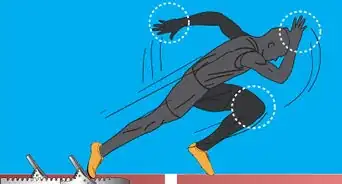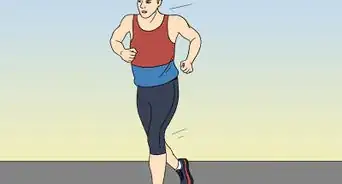wikiHow is a “wiki,” similar to Wikipedia, which means that many of our articles are co-written by multiple authors. To create this article, 79 people, some anonymous, worked to edit and improve it over time.
wikiHow marks an article as reader-approved once it receives enough positive feedback. This article received 28 testimonials and 84% of readers who voted found it helpful, earning it our reader-approved status.
This article has been viewed 607,375 times.
Learn more...
The javelin toss, a popular track and field sport in the Olympic games as well as in high school and college, involves hurling a metal-tipped spear as far as possible. Throwing the javelin correctly involves a mastery of technique and requires strength and stability. Note that these instructions assume a right-handed thrower; switch right and left for a left-hander.
Steps
Approaching the Throw
-
1Grip the pole correctly. To hold the javelin properly, you have to place it in the crease of your hand. You need to keep the point of the javelin pointed in the direction you want to throw in. Keep the javelin lined up with your eyes. When running up and transitioning to throw the javelin, look in the direction you are throwing. It has to lie along the length of your palm instead of across from it. You have to hold the javelin at the back of the cord, which is the grip placed around the center of gravity of the pole. One finger needs to be placed beyond the edge of the binding. Just make sure to keep your fist nice and relaxed, not tensed. Beyond that, there are three main grips that you can choose from.[1]
- The American grip: For this grip, you have to place your thumb and the first two joints of your index finger behind the cord. Think of it like wrapping your hand around the pole normally, except that your index finger is extended a bit more in comparison to your other fingers.
- The Finnish grip: For this grip, you have to place your thumb and the first two joints of your index finger behind the cord, while the index finger supports the shaft of the pole. This is like the American grip, except that the index finger is extended further away, and the middle finger is a bit removed from the ring and pinkie fingers.
- The "V" grip: For this grip, you should hold the javelin between your index and middle fingers, behind the cord. Think of it like making a peace sign and then placing it below the pole.
-
2Hold the javelin up near your head. Before you begin running, lift the javelin up above your shoulder so that it is about even with your head. The tip should point down towards the ground slightly, but otherwise the javelin should be parallel to the ground.[2]
- Point your elbow slightly forward, while keeping your bicep parallel to the ground.
- Turn your palm toward the sky, creating a natural platform for the javelin to rest on.
Advertisement -
3Take the "Approach Run." After you have the javelin in position, you can start the approach. Begin running towards your target with the javelin. If you are a beginner, then you can just take about 9 to 14 steps. If you are more experienced, then take 14 to 20 steps.[3] As you take your approach run, make sure that you:
- Keep your hips high and run on the balls of your feet.
- Let your free arm swing across your body.
- Flex the arm carrying the javelin to fix its position.
-
4Perform the "Withdrawal." The withdrawal phase is when you get your body into the proper throwing position. When you're ready for the withdrawal, speed up a little bit and allow the arm that is holding the javelin to extend fully behind you.[4]
- Keep your head facing in the direction of your target.
- Turn so that the left side of your body is facing your target as well.
-
5Make the "Transition." This is also known as the "cross-over". This is where you get into the javelin tosser's "lean-back" position by putting your right foot ahead of your center of gravity. As you do this, pull the javelin back a little further so that the tip is lined up with your eyebrows.[5]
- Keep the right foot close to the ground.
- Let the right heel touch the ground.
- As the right foot moves forward, move the left foot up and lean your trunk back at a 115-degree angle. This phase is finished when your right foot is on the ground and your left leg is forward and elevated.
Performing the Delivery
-
1Do the "Pre-Delivery Stride." This is the step you take just before you throw the javelin. Move your left leg forward and direct your shoulders and hips towards your target.[6]
- Wait for your left foot to touch the ground.
- Straighten your torso.
- Turn your face toward the direction of the throw. The javelin should be parallel to your shoulders.
- Position your throwing hand above shoulder level.
-
2Perform the "Delivery." Throw the javelin when your arm is up as high as possible. Once the left foot hits the ground, your left side must be ready to hold the weight of your right leg, which drives up and forward and brings the hips into a right angle with the throw. You should plant your left heel and thrust forward with your right.[7]
- After the hip thrust, pull back with your left arm keeping it parallel to your right shoulder. This will help to keep your right shoulder and chest moving forward and aligning with your hips. As this is taking place, continue following through with the throwing arm with the elbow leading.
- Move your throwing shoulder over your left leg. Your hand should follow through (the entire shoulder, elbow, and hand should move through similar to a bullwhip acting as one with each section following one after the other.
- Lift your left leg and move your throwing arm, with the elbow placed high and close to the mid line. The javelin release angle should account for aerodynamic lift and drag. Experts recommend 33 degrees as the optimum angle.
- When your arm reaches the top of its arc, let go of the javelin. Your arm should be over your head, in front of you, and not behind your back, when you release the javelin.
-
3Move into "Recovery." You have to make sure to follow through after you throw the javelin, allowing your throwing arm to travel diagonally across your body. If you're throwing with your right hand, the hand should end up in front of your left side. The left foot is on the ground. The right leg passes it and then stops you. How quickly you stop depends on how much momentum you built during the run-up. Usually, it can take as much as seven feet (2.1 meters).[8]
- You should end up standing on your right foot, with your left leg up behind you. Your right shoulder will turn left, with your chest facing to the left.
- People who throw the javelin on a professional level sometimes even fall forward due to the extreme momentum they build up from throwing the javelin and following through.
-
4Keep practicing. If you want to become an expert at throwing the javelin, or just to place in a track meet at your high school, then you've got to keep at it. Training for the javelin means more than just throwing over and over again, which can actually hurt your arm and shoulder; you'll also have to commit to a strength training routine that will build muscle, giving you even more power to throw the javelin.
- Remember that it's not the strongest or biggest people on the field who can throw the javelin the farthest. It's the people with the best technique. That said, building up your strength can only help you.
Community Q&A
-
QuestionHow do I get a javelin to land point down?
 Community AnswerFlick your wrist a bit and the javelin will go forward and the force of your wrist will bring the point to the ground.
Community AnswerFlick your wrist a bit and the javelin will go forward and the force of your wrist will bring the point to the ground. -
QuestionWhere should my force be focused?
 Community AnswerIn the hips and stomach. That will allow you to exert more power into your throw.
Community AnswerIn the hips and stomach. That will allow you to exert more power into your throw. -
QuestionWhat kind of training should I do for a javelin throw?
 Community AnswerTraining should consist of full body strength workouts to maximize power. It should also include some yoga or stretching in order to have flexibility and a larger arc creating more momentum for the javelin. Above all, technique is extremely important for all throwing events because that is what ultimately decides whose javelin goes the furthest. A good coach coach and a video camera are a must as well.
Community AnswerTraining should consist of full body strength workouts to maximize power. It should also include some yoga or stretching in order to have flexibility and a larger arc creating more momentum for the javelin. Above all, technique is extremely important for all throwing events because that is what ultimately decides whose javelin goes the furthest. A good coach coach and a video camera are a must as well.
Warnings
- Don't let people stand to your side or along angles in front of the path of your throw. Keep any onlookers behind you. This is because you might accidentally hit them with the javelin and cause a serious injury.⧼thumbs_response⧽
Things You'll Need
- Javelin
- Ample throwing room
- Preferably a "roped" off landing area.
References
- ↑ http://www.brianmac.co.uk/javelin/
- ↑ http://track.isport.com/track-guides/how-to-throw-the-javelin
- ↑ http://track.isport.com/track-guides/how-to-throw-the-javelin
- ↑ http://track.isport.com/track-guides/how-to-throw-the-javelin
- ↑ http://track.isport.com/track-guides/how-to-throw-the-javelin
- ↑ http://www.brianmac.co.uk/javelin/
- ↑ http://www.brianmac.co.uk/javelin/
- ↑ http://www.brianmac.co.uk/javelin/
- Videos provided by World Sport
About This Article
Get in javelin-throwing position by standing with your non-dominant foot forward and holding the javelin in your dominant hand so that it’s eye-level and parallel to the ground. As you approach, run about 9-14 steps, and keep the arm holding the javelin flexed and in control. When you’re ready to throw, turn so that the non-dominant side of your body is facing your target and the arm holding the javelin is extended behind you. Put your right foot ahead of your center of gravity, and launch! To learn about the various javelin pole grips and to read more throwing tips, scroll down!


























































